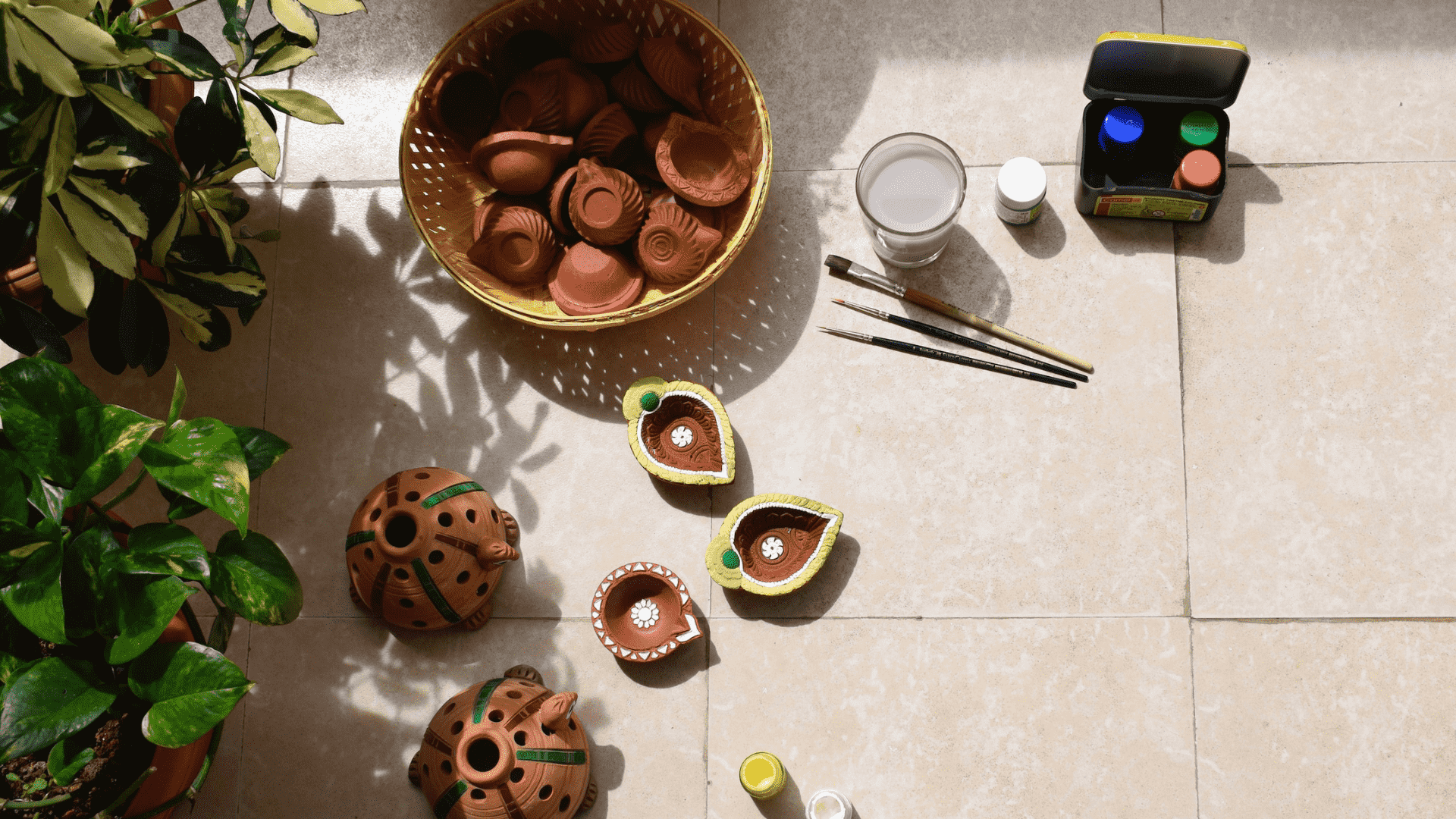Acrylics are a versatile and easy-to-use paint medium, but how well do they adhere to ceramic bisque or glazed surfaces?
In my testing, I’ve found acrylics can work great on ceramics as long as you properly prepare the surface and seal the finished piece. Here’s what I’ve learned.
Prepping the Ceramic Before Painting
The most important step with any painting project is making sure you start with a clean surface. Use mild dish soap and warm water to wash any ceramic piece you want to paint.
This removes any dirt, dust, oils, or manufacturing residues that could prevent paint from adhering properly.
If there’s any glossy glaze or old paint on the ceramic, sand it lightly to create some texture—this gives the acrylic paint something to grip.
After cleaning, you’ll also want to apply a primer or gesso before adding any acrylic paint. Primers help seal porous ceramic materials so the paint doesn’t just soak in or crack.
For acrylics, I like to use a fast-drying acrylic gesso or a primer made specifically for ceramics. Avoid oil-based primers, which can repel water-based acrylic paint.
Apply the primer evenly in a thin layer and let it fully dry before painting.
Choosing Acrylic Paints for Ceramics
Not all acrylic paints are well-suited for painting on non-canvas surfaces like ceramics. It’s important to choose paints designed for versatility and flexibility.
I recommend heavy-body acrylic paints from reputable brands like Liquitex or Golden for ceramics. Their thicker consistency allows you to build up layers of color without it cracking or chipping easily once dry.
Stay away from cheap craft acrylics not formulated for using on porous materials.
I like to use a mix of both opaque and translucent paints when doing ceramic pieces.
The opaque colors provide great coverage for large areas, while translucent tints work nicely for glazing effects. Metallics and iridescents are also fun to blend for cool ceramic paint effects.
Just stick to paint labeled non-toxic if you plan to use the ceramic for food purposes after painting.
Brush vs. Sponge vs. Rags for Applying Paint
There are a few options for how to apply acrylic paint to ceramics. Brushes give you good control for detail work but you need a very light touch to avoid dripping or brushstrokes.
I prefer smooth, synthetic brushes for acrylics. Sponges and rags work better for evenly applying base coats of paint with more texture.
Always dab or stipple tools against the surface rather than rubbing, which can pull off dried paint.
I’ve found the best approach is to start by “color blocking” large areas with sponges or rags, then come back to add finer details and blending with brushes once layers are mostly dry.
Make sure not to apply the acrylic paint too thick. It’s better to build up color in several thin layers, allowing each coat to fully dry before adding more.
This prevents cracking or bubbling from the paint drying too quickly.
Sealing the Painted Ceramic
The most important finishing step is applying a sealer once your acrylic painted ceramic piece has dried for at least 24 hours.
Since acrylic paint is water-based, it needs to be sealed for protection from moisture, heat, and wear.
For ceramics that may hold food or liquids, I recommend using a dishwasher-safe polyurethane varnish.
Carefully brush multiple thin coats of sealant over the entire painted surface and edges. Avoid immersing the ceramic in water until the varnish has had about two weeks to fully cure. Re-apply a fresh layer of sealant every year or so to maintain its protective qualities. Avoid placing acrylic painted ceramics in the microwave or oven, which can damage the paint and varnish over time.
Now that you know the basics steps for prepping, painting, and sealing ceramics with acrylics, you can confidently try this fun DIY painting project!
With the right materials and techniques, acrylic paint works great for adding colorful designs to ceramic mugs, plates, bowls, figurines, and more. Just be sure to read the manufacturer’s instructions for any sealant to ensure it’s food-safe for the type of ceramic you’re painting. Get creative and enjoy making your ceramic pieces pop with acrylics!
Key Takeaways
Acrylic paint may not withstand repeated, vigorous cleaning or excessive handling.
It can chip or scratch off if used on the bottom of plates, serving trays, or surfaces touched often.
Over time, acrylic paint is less durable on ceramics than ceramic glazes that are kiln-fired into the clay.
Colors like red and orange don’t bond as well to ceramic as blues and greens.
Certain ceramic materials like terra-cotta absorb more paint making colors uneven.
Painted pieces shouldn’t be microwave or dishwasher safe depending on circumstances.
Acrylic likely won’t achieve a smooth, professional spray-painted look. Brush strokes will be visible.
Acrylic Paint on Ceramics FAQs
Now that we’ve covered the basics of prepping and painting ceramics with acrylics, you may still have some common questions. Here I’ll tackle some frequently asked tips for getting the best results using acrylic paint on ceramic materials.
What Types of Ceramic Can be Painted with Acrylics?
Acrylic paint works best on porous, absorbent ceramic surfaces like bisque, terra cotta, earthenware, and unglazed stoneware. The paint soaks slightly into the tiny pores, creating a mechanical bond when dry. Non-porous ceramics like glazed china, porcelain, or quartz can also be painted, but require extra sanding and priming first to create tooth for adhesion.
How Durable and Permanent is Acrylic Paint on Ceramic Pieces?
With proper surface prep and sealing, acrylic paint can last for many years on ceramic surfaces with only minor touch-ups needed over time. Acrylic is not as durable as commercial ceramic paints and colors fired into glazes, but it stands up better than simple craft paints. As long as you avoid soaking, intense heat, and abrasion, acrylic holds up reasonably well on items like mugs, plates, pots, and decor.
Is Acrylic Paint Safe to Use on Ceramic Dishes and Mugs?
Yes, when applied correctly in thin layers and sealed with a food-safe varnish rated for high temperatures, acrylic paint works safely on ceramic dining ware like mugs, plates and bowls. I recommend dishwasher-safe polyurethane designed for ceramics. Avoid paints with resin, metals or solvents. Always let pieces fully cure before use and reapply sealant annually for safety.
What Kind of Primer Works Best Under Acrylic Paint on Ceramics?
For most ceramic painting projects, I’d recommend a fast-drying acrylic gesso primer or a specially formulated ceramic primer. These provide good adhesion for acrylic paint without softening or bubbling like some oil-based primers can. They dry clear to allow the paint colors to really pop.
How Should Acrylic Paint be Sealed When Used on Ceramic Pieces?
Polyurethane varnishes give the best protective seal for acrylic paint on ceramics. I typically apply 2-3 thin coats, letting each dry fully before adding the next. This prevents brushstrokes and drips while building protective layers. For dishware, choose a water-based polyurethane spray rated food-safe and heat/dishwasher-safe up to 450°F.
Is it Safe to Put Acrylic Painted Ceramics in the Oven or Dishwasher?
It’s best to avoid exposing acrylic painted ceramics to high temperatures in the microwave or oven, which can damage the paint over time. Handwashing is gentler, but you can place pieces painted with the right materials in the dishwasher safely if needed. Be sure all paints and sealants are rated food-safe and dishwasher/heat-safe before doing so.
What Causes Acrylic Paint to Crack or Chip When Used on Ceramics?
Chipping or cracking most often occurs from inadequate surface prep, paint applied too thick, humidity preventing proper curing, or lack of a protective top coat sealant. Ensure the ceramic is fully cleaned, lightly sanded, and primed before painting in thin layers. Allow a full 24-48 hours of cure time and seal with a flexible varnish rated for ceramics.
Let me know if you have any other questions! Proper materials and techniques allow acrylic paint to work quite well on many ceramic surfaces. Just take care to follow the right application and sealing steps for a long-lasting painted finish.

